University Nursing OSCE Reflection: Airway Nurse Experience
VerifiedAdded on 2023/01/23
|5
|1187
|68
Journal and Reflective Writing
AI Summary
This reflective essay, based on a student's OSCE experience, analyzes the role of an airway nurse in a simulated clinical scenario involving a patient with COPD. The essay uses Gibbs' reflective cycle to explore the student's feelings, evaluation of actions, analysis of strengths and weaknesses, and a proposed action plan for future improvement. The student identifies key areas for improvement, including hand hygiene, interdisciplinary communication, and assessment of chest sounds after nebulization. The reflection highlights adherence to medication administration rights and the importance of person-centered care. References to relevant literature support the analysis, demonstrating a commitment to evidence-based practice. The student aims to enhance clinical skills and patient outcomes through continuous learning and adherence to OSCE guidelines. The assignment is published on Desklib, a platform providing resources for students.
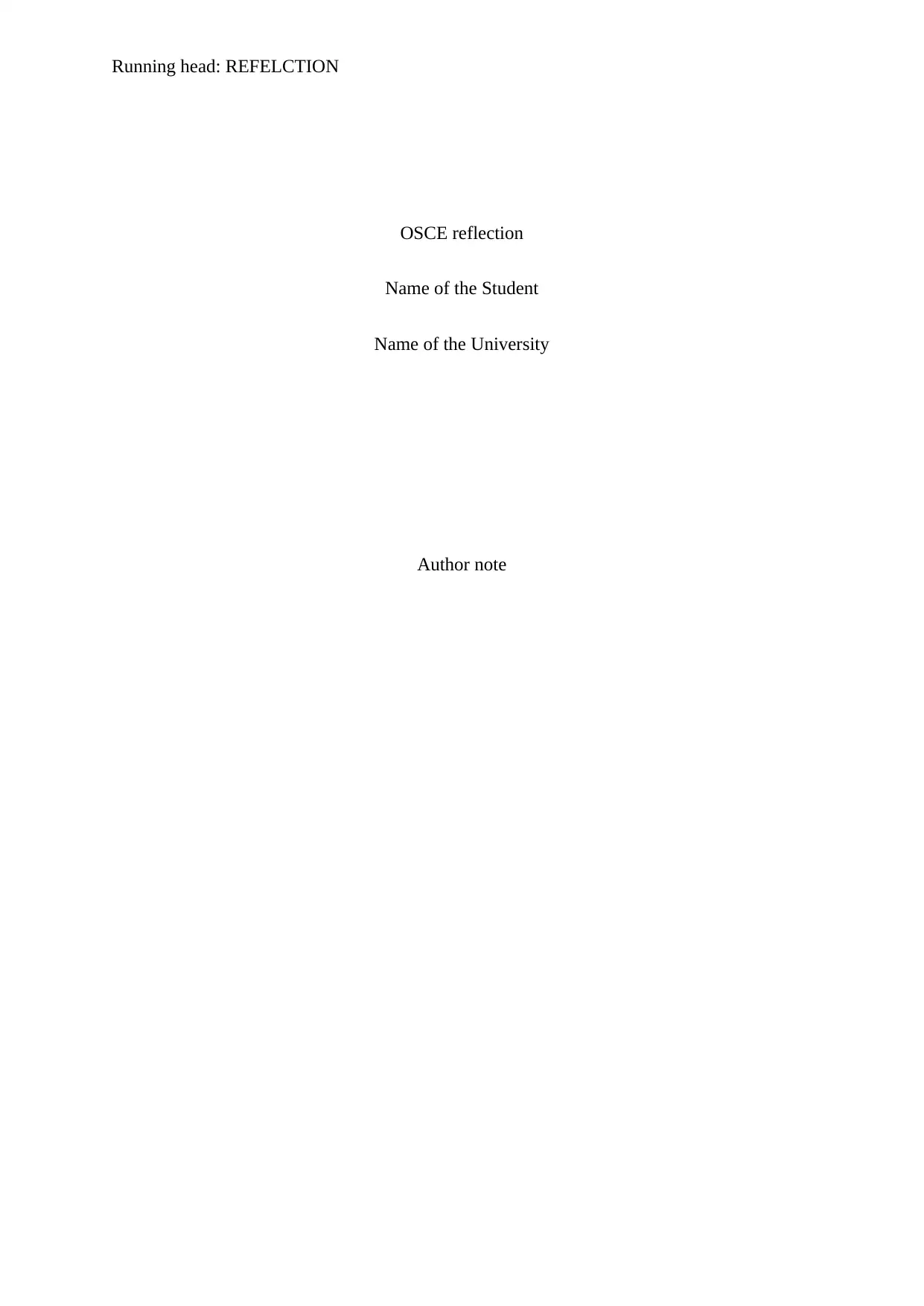
Running head: REFELCTION
OSCE reflection
Name of the Student
Name of the University
Author note
OSCE reflection
Name of the Student
Name of the University
Author note
Paraphrase This Document
Need a fresh take? Get an instant paraphrase of this document with our AI Paraphraser
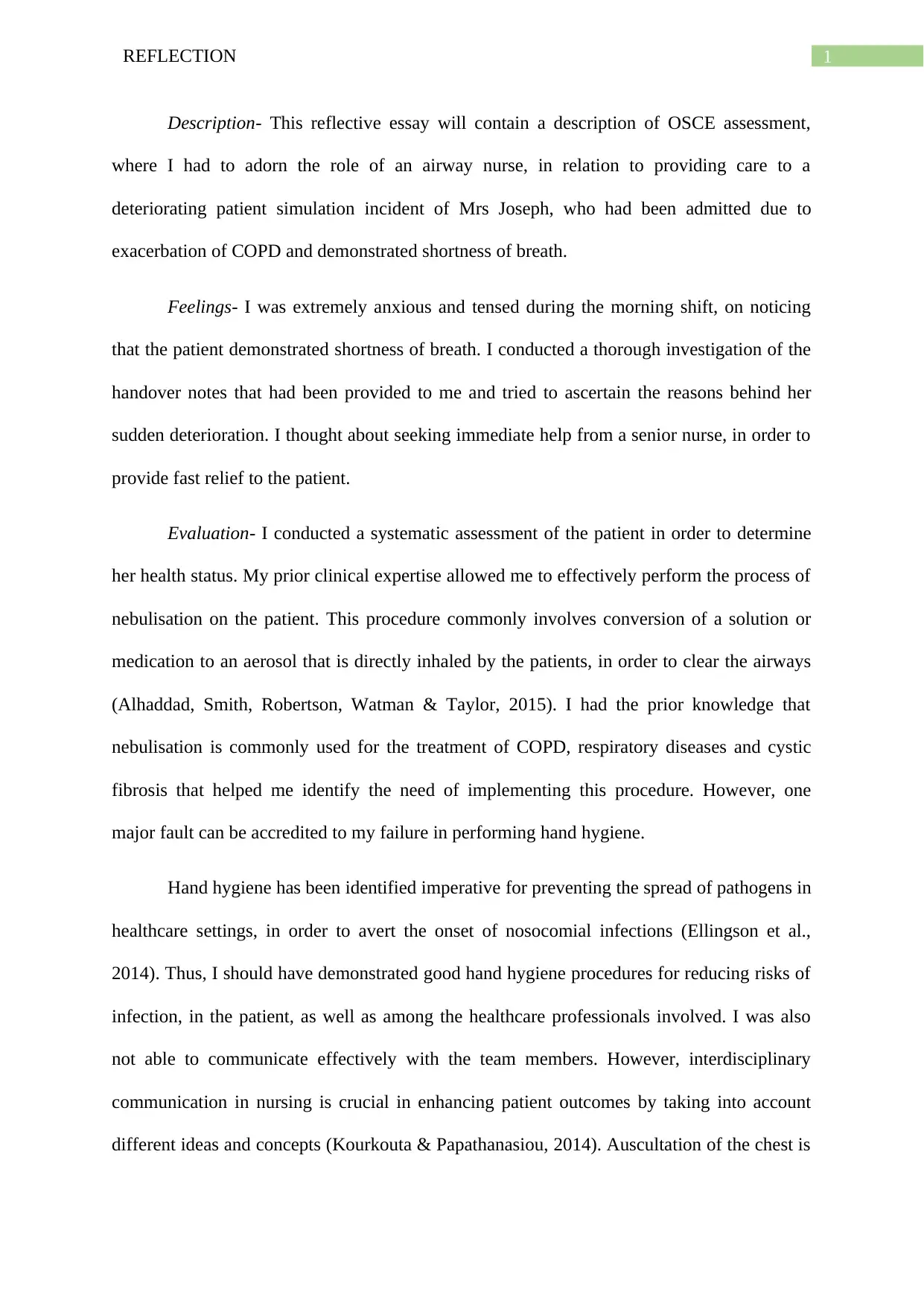
1REFLECTION
Description- This reflective essay will contain a description of OSCE assessment,
where I had to adorn the role of an airway nurse, in relation to providing care to a
deteriorating patient simulation incident of Mrs Joseph, who had been admitted due to
exacerbation of COPD and demonstrated shortness of breath.
Feelings- I was extremely anxious and tensed during the morning shift, on noticing
that the patient demonstrated shortness of breath. I conducted a thorough investigation of the
handover notes that had been provided to me and tried to ascertain the reasons behind her
sudden deterioration. I thought about seeking immediate help from a senior nurse, in order to
provide fast relief to the patient.
Evaluation- I conducted a systematic assessment of the patient in order to determine
her health status. My prior clinical expertise allowed me to effectively perform the process of
nebulisation on the patient. This procedure commonly involves conversion of a solution or
medication to an aerosol that is directly inhaled by the patients, in order to clear the airways
(Alhaddad, Smith, Robertson, Watman & Taylor, 2015). I had the prior knowledge that
nebulisation is commonly used for the treatment of COPD, respiratory diseases and cystic
fibrosis that helped me identify the need of implementing this procedure. However, one
major fault can be accredited to my failure in performing hand hygiene.
Hand hygiene has been identified imperative for preventing the spread of pathogens in
healthcare settings, in order to avert the onset of nosocomial infections (Ellingson et al.,
2014). Thus, I should have demonstrated good hand hygiene procedures for reducing risks of
infection, in the patient, as well as among the healthcare professionals involved. I was also
not able to communicate effectively with the team members. However, interdisciplinary
communication in nursing is crucial in enhancing patient outcomes by taking into account
different ideas and concepts (Kourkouta & Papathanasiou, 2014). Auscultation of the chest is
Description- This reflective essay will contain a description of OSCE assessment,
where I had to adorn the role of an airway nurse, in relation to providing care to a
deteriorating patient simulation incident of Mrs Joseph, who had been admitted due to
exacerbation of COPD and demonstrated shortness of breath.
Feelings- I was extremely anxious and tensed during the morning shift, on noticing
that the patient demonstrated shortness of breath. I conducted a thorough investigation of the
handover notes that had been provided to me and tried to ascertain the reasons behind her
sudden deterioration. I thought about seeking immediate help from a senior nurse, in order to
provide fast relief to the patient.
Evaluation- I conducted a systematic assessment of the patient in order to determine
her health status. My prior clinical expertise allowed me to effectively perform the process of
nebulisation on the patient. This procedure commonly involves conversion of a solution or
medication to an aerosol that is directly inhaled by the patients, in order to clear the airways
(Alhaddad, Smith, Robertson, Watman & Taylor, 2015). I had the prior knowledge that
nebulisation is commonly used for the treatment of COPD, respiratory diseases and cystic
fibrosis that helped me identify the need of implementing this procedure. However, one
major fault can be accredited to my failure in performing hand hygiene.
Hand hygiene has been identified imperative for preventing the spread of pathogens in
healthcare settings, in order to avert the onset of nosocomial infections (Ellingson et al.,
2014). Thus, I should have demonstrated good hand hygiene procedures for reducing risks of
infection, in the patient, as well as among the healthcare professionals involved. I was also
not able to communicate effectively with the team members. However, interdisciplinary
communication in nursing is crucial in enhancing patient outcomes by taking into account
different ideas and concepts (Kourkouta & Papathanasiou, 2014). Auscultation of the chest is
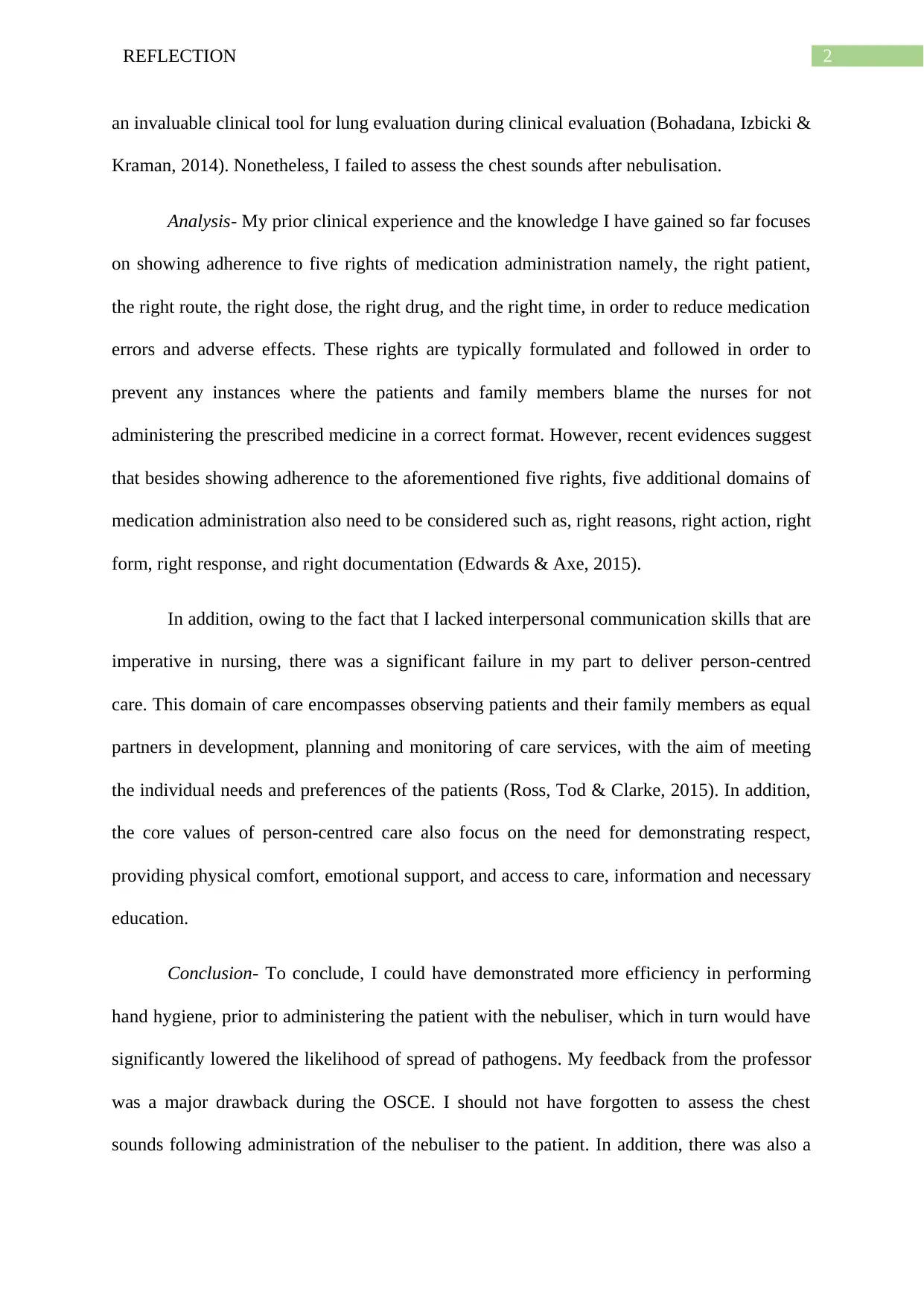
2REFLECTION
an invaluable clinical tool for lung evaluation during clinical evaluation (Bohadana, Izbicki &
Kraman, 2014). Nonetheless, I failed to assess the chest sounds after nebulisation.
Analysis- My prior clinical experience and the knowledge I have gained so far focuses
on showing adherence to five rights of medication administration namely, the right patient,
the right route, the right dose, the right drug, and the right time, in order to reduce medication
errors and adverse effects. These rights are typically formulated and followed in order to
prevent any instances where the patients and family members blame the nurses for not
administering the prescribed medicine in a correct format. However, recent evidences suggest
that besides showing adherence to the aforementioned five rights, five additional domains of
medication administration also need to be considered such as, right reasons, right action, right
form, right response, and right documentation (Edwards & Axe, 2015).
In addition, owing to the fact that I lacked interpersonal communication skills that are
imperative in nursing, there was a significant failure in my part to deliver person-centred
care. This domain of care encompasses observing patients and their family members as equal
partners in development, planning and monitoring of care services, with the aim of meeting
the individual needs and preferences of the patients (Ross, Tod & Clarke, 2015). In addition,
the core values of person-centred care also focus on the need for demonstrating respect,
providing physical comfort, emotional support, and access to care, information and necessary
education.
Conclusion- To conclude, I could have demonstrated more efficiency in performing
hand hygiene, prior to administering the patient with the nebuliser, which in turn would have
significantly lowered the likelihood of spread of pathogens. My feedback from the professor
was a major drawback during the OSCE. I should not have forgotten to assess the chest
sounds following administration of the nebuliser to the patient. In addition, there was also a
an invaluable clinical tool for lung evaluation during clinical evaluation (Bohadana, Izbicki &
Kraman, 2014). Nonetheless, I failed to assess the chest sounds after nebulisation.
Analysis- My prior clinical experience and the knowledge I have gained so far focuses
on showing adherence to five rights of medication administration namely, the right patient,
the right route, the right dose, the right drug, and the right time, in order to reduce medication
errors and adverse effects. These rights are typically formulated and followed in order to
prevent any instances where the patients and family members blame the nurses for not
administering the prescribed medicine in a correct format. However, recent evidences suggest
that besides showing adherence to the aforementioned five rights, five additional domains of
medication administration also need to be considered such as, right reasons, right action, right
form, right response, and right documentation (Edwards & Axe, 2015).
In addition, owing to the fact that I lacked interpersonal communication skills that are
imperative in nursing, there was a significant failure in my part to deliver person-centred
care. This domain of care encompasses observing patients and their family members as equal
partners in development, planning and monitoring of care services, with the aim of meeting
the individual needs and preferences of the patients (Ross, Tod & Clarke, 2015). In addition,
the core values of person-centred care also focus on the need for demonstrating respect,
providing physical comfort, emotional support, and access to care, information and necessary
education.
Conclusion- To conclude, I could have demonstrated more efficiency in performing
hand hygiene, prior to administering the patient with the nebuliser, which in turn would have
significantly lowered the likelihood of spread of pathogens. My feedback from the professor
was a major drawback during the OSCE. I should not have forgotten to assess the chest
sounds following administration of the nebuliser to the patient. In addition, there was also a
⊘ This is a preview!⊘
Do you want full access?
Subscribe today to unlock all pages.

Trusted by 1+ million students worldwide
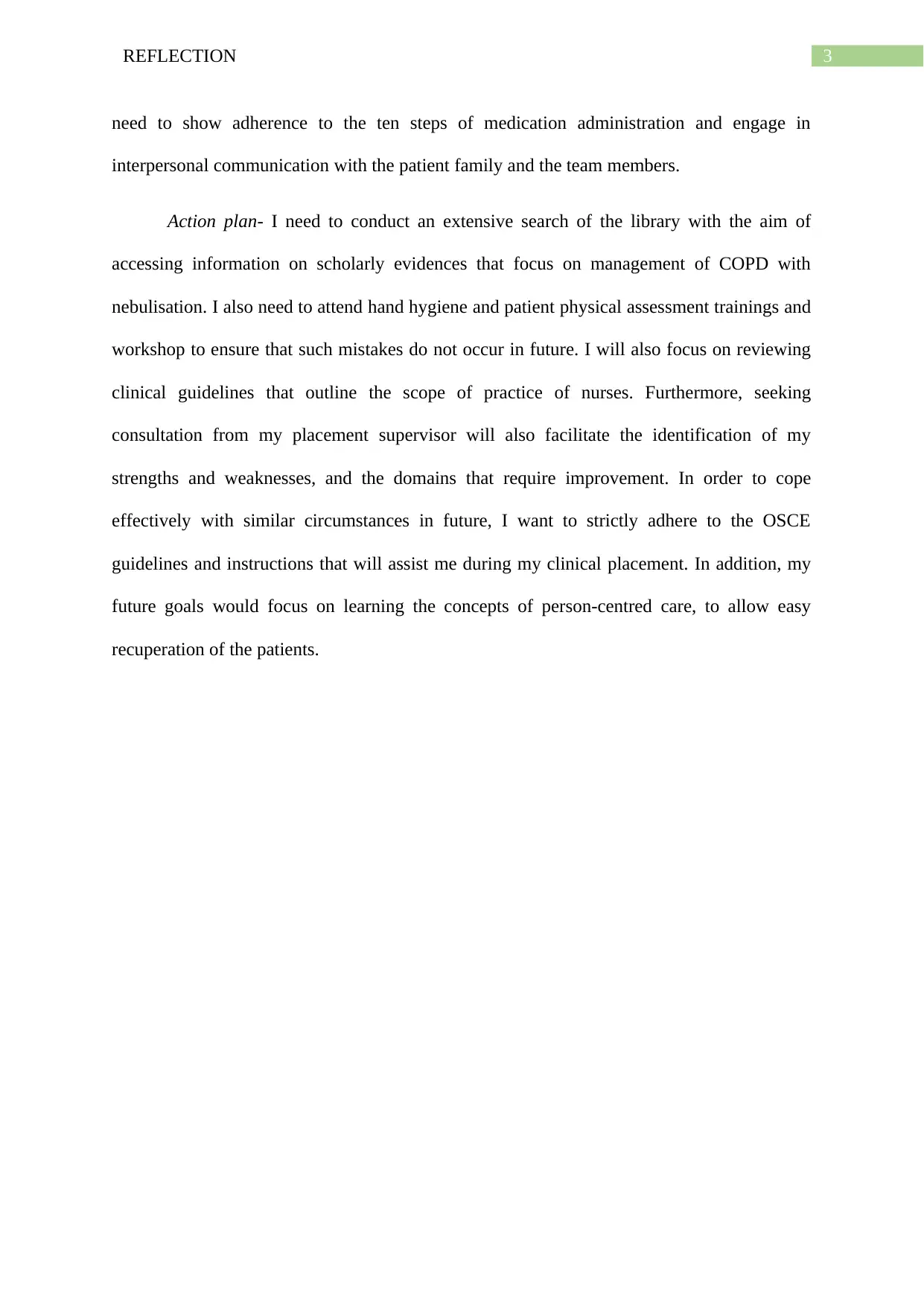
3REFLECTION
need to show adherence to the ten steps of medication administration and engage in
interpersonal communication with the patient family and the team members.
Action plan- I need to conduct an extensive search of the library with the aim of
accessing information on scholarly evidences that focus on management of COPD with
nebulisation. I also need to attend hand hygiene and patient physical assessment trainings and
workshop to ensure that such mistakes do not occur in future. I will also focus on reviewing
clinical guidelines that outline the scope of practice of nurses. Furthermore, seeking
consultation from my placement supervisor will also facilitate the identification of my
strengths and weaknesses, and the domains that require improvement. In order to cope
effectively with similar circumstances in future, I want to strictly adhere to the OSCE
guidelines and instructions that will assist me during my clinical placement. In addition, my
future goals would focus on learning the concepts of person-centred care, to allow easy
recuperation of the patients.
need to show adherence to the ten steps of medication administration and engage in
interpersonal communication with the patient family and the team members.
Action plan- I need to conduct an extensive search of the library with the aim of
accessing information on scholarly evidences that focus on management of COPD with
nebulisation. I also need to attend hand hygiene and patient physical assessment trainings and
workshop to ensure that such mistakes do not occur in future. I will also focus on reviewing
clinical guidelines that outline the scope of practice of nurses. Furthermore, seeking
consultation from my placement supervisor will also facilitate the identification of my
strengths and weaknesses, and the domains that require improvement. In order to cope
effectively with similar circumstances in future, I want to strictly adhere to the OSCE
guidelines and instructions that will assist me during my clinical placement. In addition, my
future goals would focus on learning the concepts of person-centred care, to allow easy
recuperation of the patients.
Paraphrase This Document
Need a fresh take? Get an instant paraphrase of this document with our AI Paraphraser
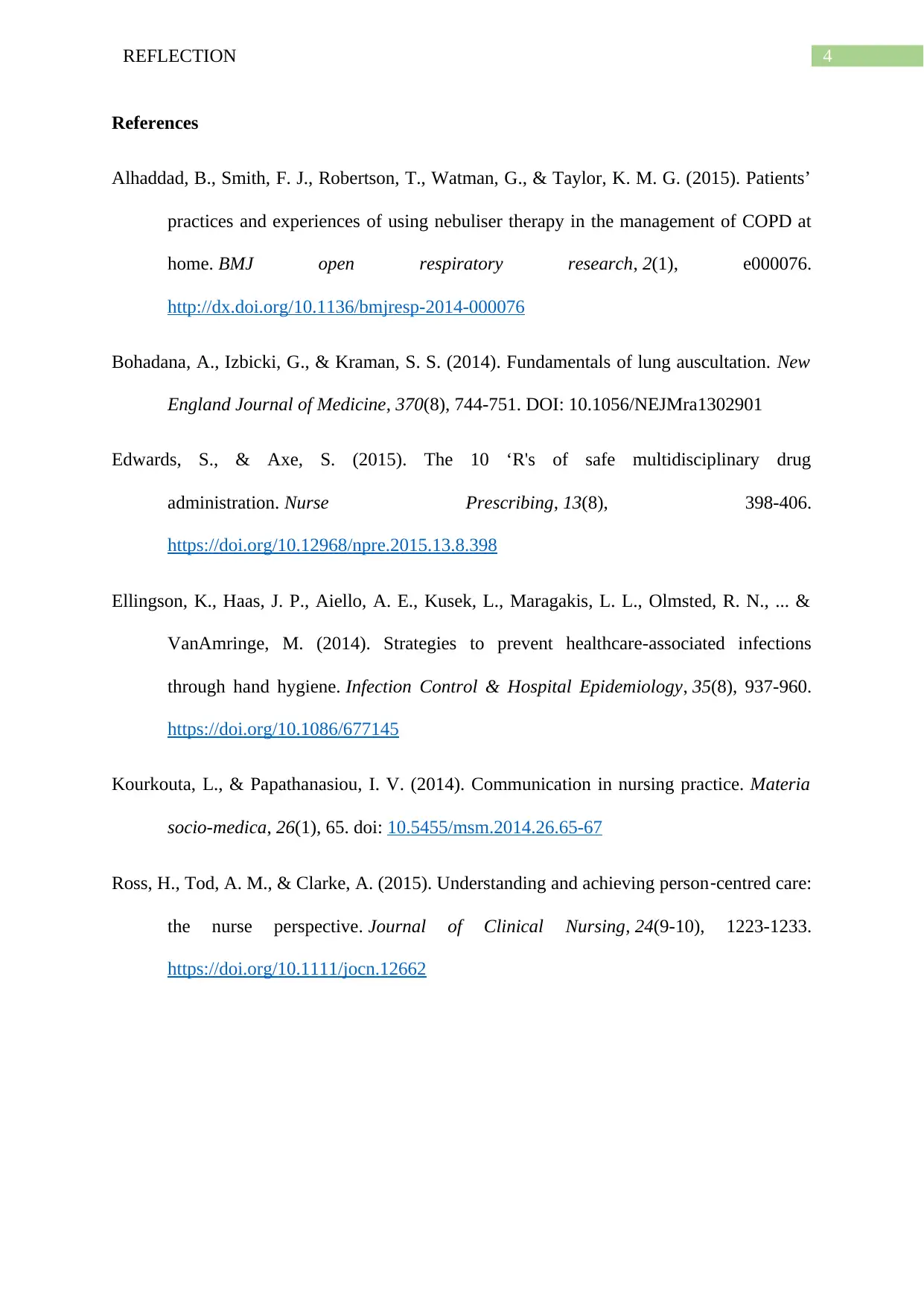
4REFLECTION
References
Alhaddad, B., Smith, F. J., Robertson, T., Watman, G., & Taylor, K. M. G. (2015). Patients’
practices and experiences of using nebuliser therapy in the management of COPD at
home. BMJ open respiratory research, 2(1), e000076.
http://dx.doi.org/10.1136/bmjresp-2014-000076
Bohadana, A., Izbicki, G., & Kraman, S. S. (2014). Fundamentals of lung auscultation. New
England Journal of Medicine, 370(8), 744-751. DOI: 10.1056/NEJMra1302901
Edwards, S., & Axe, S. (2015). The 10 ‘R's of safe multidisciplinary drug
administration. Nurse Prescribing, 13(8), 398-406.
https://doi.org/10.12968/npre.2015.13.8.398
Ellingson, K., Haas, J. P., Aiello, A. E., Kusek, L., Maragakis, L. L., Olmsted, R. N., ... &
VanAmringe, M. (2014). Strategies to prevent healthcare-associated infections
through hand hygiene. Infection Control & Hospital Epidemiology, 35(8), 937-960.
https://doi.org/10.1086/677145
Kourkouta, L., & Papathanasiou, I. V. (2014). Communication in nursing practice. Materia
socio-medica, 26(1), 65. doi: 10.5455/msm.2014.26.65-67
Ross, H., Tod, A. M., & Clarke, A. (2015). Understanding and achieving person‐centred care:
the nurse perspective. Journal of Clinical Nursing, 24(9-10), 1223-1233.
https://doi.org/10.1111/jocn.12662
References
Alhaddad, B., Smith, F. J., Robertson, T., Watman, G., & Taylor, K. M. G. (2015). Patients’
practices and experiences of using nebuliser therapy in the management of COPD at
home. BMJ open respiratory research, 2(1), e000076.
http://dx.doi.org/10.1136/bmjresp-2014-000076
Bohadana, A., Izbicki, G., & Kraman, S. S. (2014). Fundamentals of lung auscultation. New
England Journal of Medicine, 370(8), 744-751. DOI: 10.1056/NEJMra1302901
Edwards, S., & Axe, S. (2015). The 10 ‘R's of safe multidisciplinary drug
administration. Nurse Prescribing, 13(8), 398-406.
https://doi.org/10.12968/npre.2015.13.8.398
Ellingson, K., Haas, J. P., Aiello, A. E., Kusek, L., Maragakis, L. L., Olmsted, R. N., ... &
VanAmringe, M. (2014). Strategies to prevent healthcare-associated infections
through hand hygiene. Infection Control & Hospital Epidemiology, 35(8), 937-960.
https://doi.org/10.1086/677145
Kourkouta, L., & Papathanasiou, I. V. (2014). Communication in nursing practice. Materia
socio-medica, 26(1), 65. doi: 10.5455/msm.2014.26.65-67
Ross, H., Tod, A. M., & Clarke, A. (2015). Understanding and achieving person‐centred care:
the nurse perspective. Journal of Clinical Nursing, 24(9-10), 1223-1233.
https://doi.org/10.1111/jocn.12662
1 out of 5
Related Documents
Your All-in-One AI-Powered Toolkit for Academic Success.
+13062052269
info@desklib.com
Available 24*7 on WhatsApp / Email
![[object Object]](/_next/static/media/star-bottom.7253800d.svg)
Unlock your academic potential
Copyright © 2020–2025 A2Z Services. All Rights Reserved. Developed and managed by ZUCOL.




